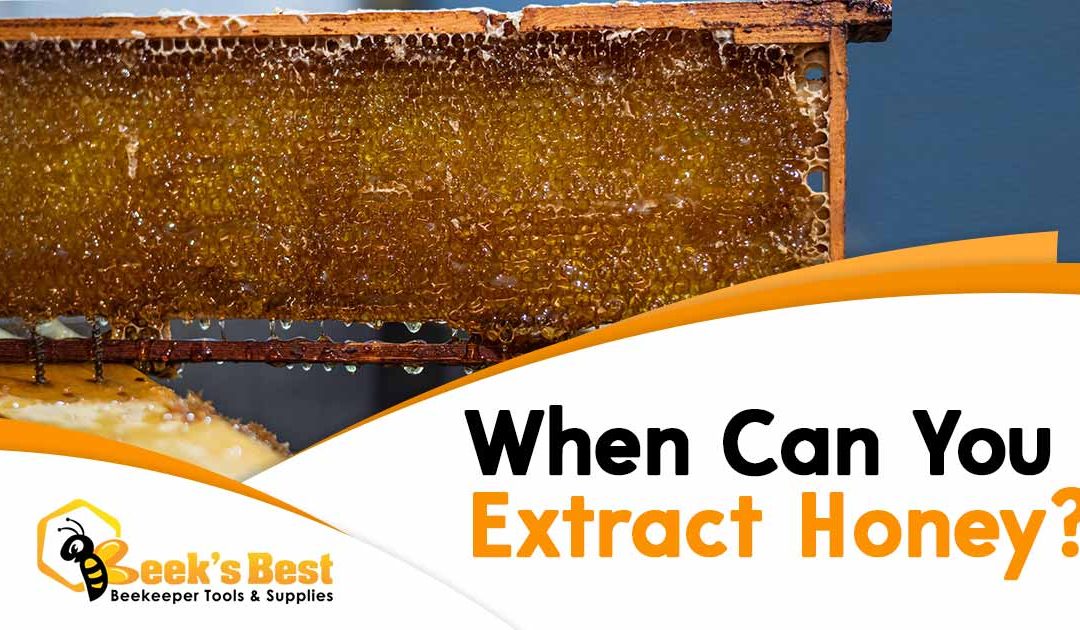Beekeeping is a rewarding practice but there are several things you need to know in order to become a successful beekeeper. One of these skills is knowing when to extract honey.
Nowadays more and more people are painting the picture of beekeeping as a very simple and hands-off operation.
While in many cases bees are self-reliant and can take care of themselves for the most part. There are some important things you must always manage as the beekeeper. Your observation and education about beekeeping will continue to promote a happy and healthy hive.
This approach will be the reason you have an excellent supply of honey to extract.
What we want to provide today is a guide of knowing when to extract honey, so you don’t take it too early, or harvest too much. Harvesting too much can cause an even bigger problem for your bees. Taking too much honey can cause starvation something you want to avoid. So, if you are curious on learning when the perfect time is to extract your honey is, keep reading.
What Does Harvesting Honey Mean?
When you hear the words harvesting honey, it means removing some of the honey the bees have made from the hive. Extraction is also a term used. It is also a process of removing honey. However, there are multiple ways to extract honey depending on if the beekeepers are commercial honey suppliers and what kind of hives they have.
Natural honeycomb honey extraction will use an entirely different extraction process then a commercial honey supplier that needs to filter out the honey in a specific way. In order to understand when to extract honey, we would like to explain a few details first. This will help you if you are new to beekeeping.
- Manage your expectations – During the first year don’t expect a very large harvest. Bees are using large amounts of nectar to produce wax at first.
- Make sure your honey is capped. In other words, make sure your honey is ripe. The honeybee ripens the honey by getting rid of most of the moisture in the honey. Then once it’s perfect for them they cover it with wax. This is where many beekeepers fail. They don’t have the patience and take the honey before it’s capped. Don’t do this.
Pro tip: The area that looks white in color when extracting from the hive is the capped area. Wax is often light in color when it’s new. This a good way to see if honey is ripe.
Key Steps to Knowing When to Extract Honey
The process of extracting honey can be different we already touched on that earlier. This is not what matters when learning when you can extract honey. What matters is education about specific characteristics for your bees. Here is what you want to know.
Region
Don’t even consider harvesting or extracting honey until you know when expected honey and nectar flows are in your location. When you know this, you are able to plan on adding supers rapidly. This will allow your bees to create and store honey at that particular time. This allows you to extract honey, and if by chance you take too much, you can have a backup because you know how the nectar flows work, giving your bees enough time to replace what you took.
What’s Your Window?
This means you understand the exact times to harvest your honey throughout the year. This is not the same for everyone because it’s dependent on where you are raising your bees (aka location and region). If you want to take this to the next level, you can learn the botanical rituals of the area.
When you extract honey to soon, you aren’t capitalizing on the full amount of honey you should receive. Conversely, if you harvest after peak time, you risk a shift in the climate which could lead to lower harvest or worse. Being fearful of a low harvest because of a change in weather could have you extract to much honey, not leaving enough for your bees in the winter months.
It’s best to know your window.
Is the Honey Ready?
Just to reiterate it’s important to know your honey. Knowing when the honey is ripe is key. Bees will remove the moisture from the honey down to about 18% moisture. The bees will then cap the honey with wax giving it a whitish color look. This means they feel it’s ready. Which means you can now extract it.
Build A Relationship with Your Bees
Learn the temperament of your bees. Understand they will most likely not appreciate you taking their honey, so try and move them to another area while you harvest. When taking honey try and only take what you really need. Don’t take too much.
A common rule is to leave between forty and sixty pounds of honey in the hive to get the bees through the colder months. This can vary if you are in a colder region, then leave a bit more. For a location with a shorter winter, you may be able to leave a little less. But have a number in mind.
In Conclusion
Knowing when to extract honey is all about educating yourself about your region, the window of opportunity, botanical behaviors, and your relationship with the bees. Also, you want to pay attention to if the honey is ripe before you remove it. And know how much you need and how much you are leaving in the hive.
As a beekeeper, you need to have great observation skills and a desire to learn about beekeeping so you can take the right actions when extracting honey. Beek’s Best is the go-to resource for all beekeeping equipment and tools. We can answer all your questions involving extracting honey and harvesting.
Give us a call at (866) 712-3357 and let us confirm with you when to extract honey from your hive.


Recent Comments